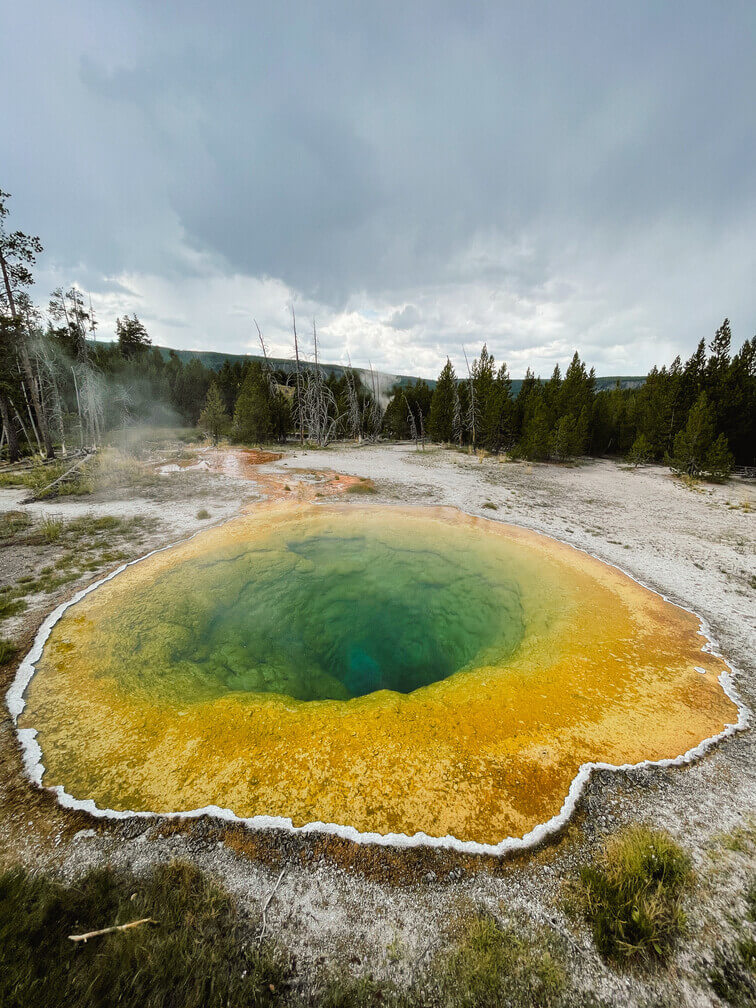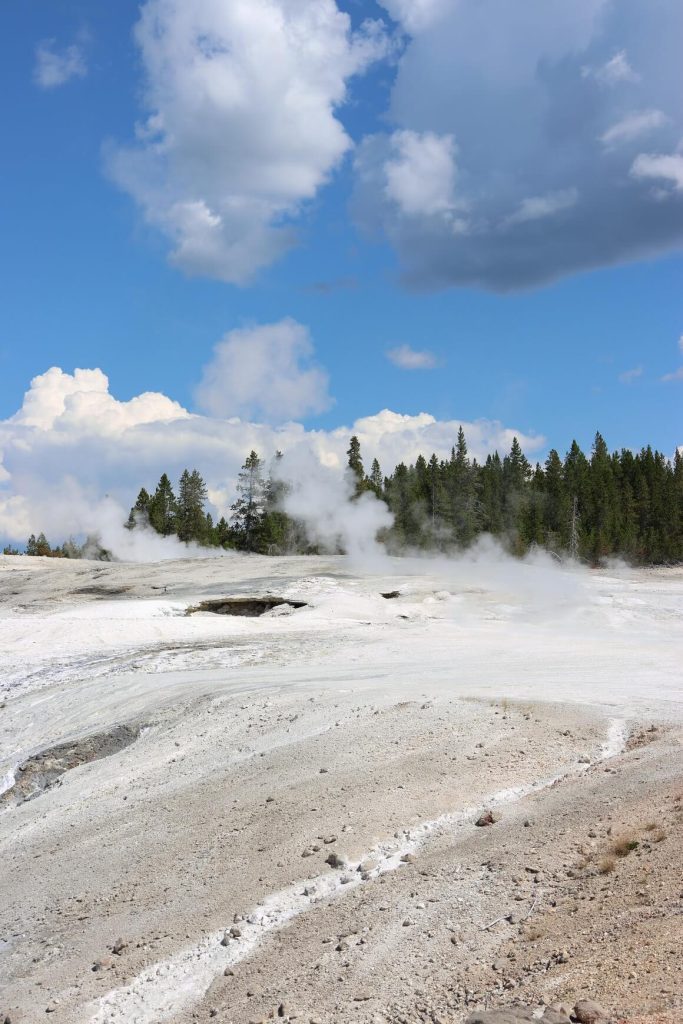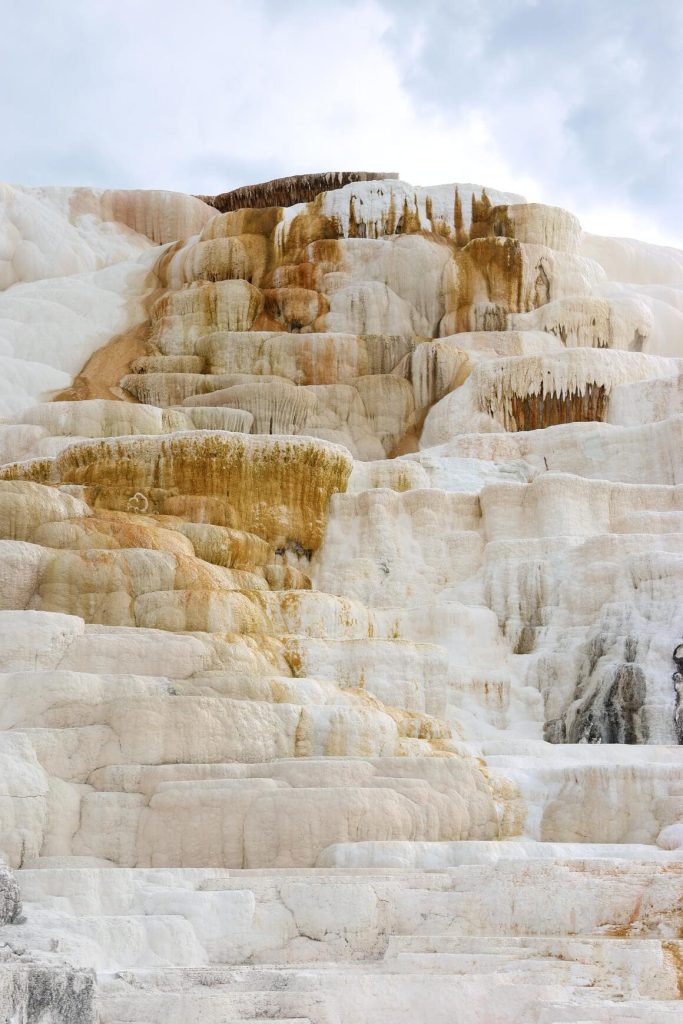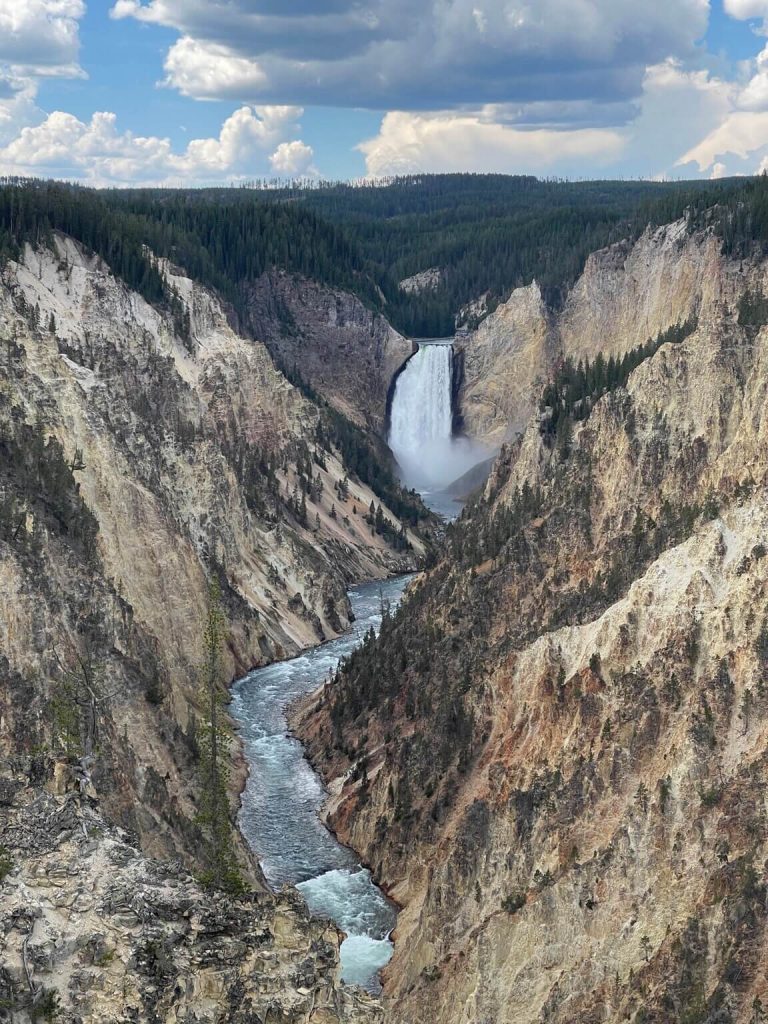Yellowstone National Park
Encompassing 2.2 million acres, Yellowstone National Park is the second largest national park in the lower 48. With so much to explore, including over 10,000 hydrothermal features, more than half the world’s geysers, 466 miles of road and over 92 trail-heads, you’ll want to decide which features to visit before you arrive.
Yellowstone National Park is world-renowned for its epic landscapes, unique wildlife, and fascinating natural history. Each year millions of people come from all over the globe to witness Yellowstone’s wonders, and for some, it has been a lifetime dream. In this blog post, I am sharing everything you need to know to plan your own trip to Yellowstone National Park, including all the best things to see and do!
It was established as a national park by US congress in 1872, and signed into law by president Ulysses S Grant. This was the first national park in the entire world, and paved the way for the protection of future national parks all over the globe. Today, Yellowstone remains as probably the most well-known of the US national parks, and in recent times has opened its gates to roughly 4 million people each year. It sits in the north-western portion of Wyoming, but a small part of the park extends into both Idaho and Montana. Within the boundaries of the park also happens to be the Yellowstone Caldera, a 34 x 45 mile super volcano within the national park. With this comes extreme volcanic and seismic activity, the reason for its thousands of geothermal features, geysers, and springs.
Taking a road trip to Yellowstone is a dream for a lot of Americans, and it’s also a huge draw for visitors from all around the globe.
VISIT YELLOWSTONE
Yellowstone is technically open year-round, but there are a lot of closures during the winter period in the park from October till May. The most popular times to visit are June through August, but personally my favorite months in the park are May, September, and early October when the crowds are smaller and it should be free of snow.
You can still visit Yellowstone during the winter, but personal vehicles will be limited to the road between Gardiner (MT) and Cooke City (MT), the only part of the park where the road is open and maintained in winter. To reach the other parts of the park you will need to have a means of cross-snow travel such as a snowmobile, or take a tour through the park on one of the snow-cats.
Be sure to check out the park’s website to research road closures before visiting as dates change every season depending on the weather.
The Yellowstone region is in a pretty remote area of the country, located almost 5 hours from the nearest major city (Salt Lake City). There are a number of ways for guests to access the park, and I will go into detail about some of them below.
HOW TO GET TO YELLOWSTONE NATIONAL PARK
The Yellowstone region is in a pretty remote area of the country, located almost 5 hours from the nearest major city (Salt Lake City). There are a number of ways for guests to access the park, and I will go into detail about some of them below.
ARRIVE BY CAR
Yellowstone has five entrance stationsthat are each located in different sections of the park. Where you are driving from previously will determine which of these you will want to enter. The most popular entrance is West Yellowstone as it is the quickest entrance to reach from Salt Lake City (4.5-5 hour drive). Salt Lake City is the nearest major city from which you can fly into and drive from. Another popular way to enter the park is the south entrance station, being just a short drive from Grand Teton National Park and Jackson Hole Airport.
ARRIVE BY PLANE
While you cannot fly directly into Yellowstone National Park, you can fly into one of a few nearby towns. The closest of which is West Yellowstone, only a short 5 minute drive from the West Yellowstone entrance. Bozeman (MT) and Jackson Hole (WY) are a couple of alternate options, both being less than a 1.5 hour drive from Yellowstone entrances.

BEST THINGS TO DO IN YELLOWSTONE NATIONAL PARK
Yellowstone National Park is a huge park, with so many stops along the way to keep visitors busy. As such, below you will find each area broken down into it’s own section along with my top recommendations.
Upper Geyser Basin is the busiest area of the park, and for good reason! Here there is ample parking, a gas station, lodging, a variety of food options, and access to many hiking trails.
It is also home to the famous Old Faithful Geyser, which was first discovered in 1872 and named for its long history of predictable eruptions. This is one of the biggest tourist attractions in the park, and can get very busy. I recommend visiting it in the early morning or later in the evening when it will be a little quieter. You can see the estimated time of the next eruption on the board at the nearby visitor center.
This area is also home to the most densely populated geyser basin in the world, the Upper Geyser Basin. It can be seen via an easy 3 mile loop, and is one of my absolute favorite things to do in Yellowstone National Park. It’s hard to go wrong on any of the hikes in this area (they’re all spectacular!) but you can join a guided hike if you want to get a little more local knowledge while you explore.
Many of these geysers along this walk go off at regular, predictable intervals, so be sure to check in at the Old Faithful Visitor Center before beginning your hike to help you plan when to see the eruptions. Some of the must see stops are Castle Geyser, Riverside Geyser, Grotto Geyser, and Morning Glory Pool. Beehive Geyser is incredible if you can catch it going off!

BISCUIT BASIN
Just north of the Old Faithful is another beautiful part of the Upper Geyser Basin,Biscuit Basin. The best way to explore Biscuit Basin is via its short loop trail (0.65 miles). Along the way you will see geysers and colorful hot pools, including Black Opal Pool, Jewel Geyser, Sapphire Pool, Shell Spring, Mustard Spring, Avoca Spring, and Black Pearl Geyser.
GRAND PRISMATIC SPRING
The Grand Prismatic Spring is possibly the most recognizable feature in all of Yellowstone. Due to its popularity, I recommend getting here early in the morning or later in the afternoon so it’s a little quieter in terms of crowds. If you don’t want to plan all your stops yourself, consider taking a guided tour!

This full-day tour includes Grand Prismatic as one of the highlighted stops.There are two ways to see the spring. The first way is to park at the Grand Prismatic Spring Parking Lot and take a short boardwalk loop trail that goes right by the spring. This is beautiful, but if you will also want to see that famous postcard viewpoint from. To do this you will need to park at the Fairy Falls Trail Parking Lot and hike a short 1 mile round-trip trail to the overlook. Be aware there is a short but relatively steep uphill section, so those with difficulties walking may want to stick to the boardwalk mentioned previously.
GRAND CANYON OF THE YELLOWSTONE
The Grand Canyon of the Yellowstone is one of the most dramatic views in Yellowstone National Park. I remember the first time I saw it I was blown away. The powerful Lower Falls drop into a gigantic canyon, which is accented by steaming thermal features and colorful walls. Yellowstone’s Grand Canyon can be viewed from many viewpoints, but the classic view is from Artist Point. Another of my favorite viewpoints is from Uncle Tom’s Point which requires you to walk down 328 stairs down (and subsequentially back up) and 500 feet of elevation to the overlook. The payout is a really close view of the impressive lower falls, and on a sunny day, you will probably even get a beautiful rainbow! This is one of the highlighted stops on one of my most recommended guided full-day West Yellowstone tours.
NORRIS GEYSER BASIN
The Norris Geyser Basin is one of the most impressive geyser viewing areas of the park. It is home to the hottest and oldest of the geysers in the park, with some thermal features in the area dating back at least 115,000 years. It is also the home of Steamboat Geyser, the tallest geyser in the world, which can erupt up to 400 (120m) feet high! Unfortunately Steamboat’s eruptions are not on a predictable schedule, but you might just get lucky!
There are two sections to explore in the Norris Geyser Basin, one being the Porcelain Basin (3/4 mile, 1.2km), and the other being the Back Basin (1.5 miles, 2.4km). I recommend checking both out as they are relatively short walks and both have some really unique features worth seeing. If you only have time for one, Porcelain Basin would be my pick.

MAMMOTH HOT SPRINGS
The travertine terraces of Mammoth Hot Springs are a unique and beautiful sight within Yellowstone National Park. The soft, earthy tones here and so pleasing to the eye, and there are some really amazing textures throughout the landscape which are always really cool to see. The area has a few different parking lots that you can use to park for exploring these terraces, just pick one that has space and walk as far as you like. There’s a nice boardwalk that takes you from the parking lots to all of the features, but do be aware there are quite a few stairs. Mammoth Hot Springs is a popular stop on any visit to Yellowstone, so you can always explore this area with the help of a tour. This 2-day guided exploration of Yellowstone and this 4-day tour both include stops to explore here.
If you’re a history buff, you can also check out the historic Fort Yellowstone. In the early days of the national park US soldiers were sent into Yellowstone by the Secretary of Interior after issues with poaching, vandalism, etc. Their living quarters remain to this day and tours are available through the park.

LAMAR VALLEY
America’s Serengeti – this is a name often used to describe Lamar Valley. This is probably my favorite part of the whole national park, and one that I spend a lot of time in with each visit. The Lamar Valley is a large river valley surrounded by mountains and filled to the brim with wildlife. It is home to the famous Junction Butte and Lamar Canyon wolf packs, as well as huge herds of bison, pronghorn, grizzly bears, badgers, bald eagles, and more.
What I love about the Lamar Valley is that you are always bound to see something exciting. Whether it’s being held up by a large herd of bison crossing the road, a lucky encounter with one of the wolf packs, or getting to see a grizzly bear cross the Lamar River, I’ve always been left in awe by this place. Your best chance at these special sightings is getting there very early in the morning, or staying out close to sunset as the animals are more active during these times. Remember to bring binoculars! IT is also a really fun experience to visit Lamar Valley with a naturalist guide. You can book a tour that will provide all the scopes and binoculars you need, too.





HIKING TRAILS IN YELLOWSTONE

Yellowstone, although a very beautiful national park, is not one that’s famous for its hiking trails. Due to the geothermal activity in the area and abundance of wildlife, trails are kept to a minimum in the park. In saying that, there are still some really great options for those wanting to get out and move their legs. Here are a few hiking trails I recommend:
Dunraven Pass to Mount Washburn is 6.5 miles (10.4km) roundtrip and has 1400 feet of elevation gain. One of the most famous in the park, this hike takes you to an old fire lookout at the summit of Mount Washburn. Keep an eye out for Bighorn Sheep that are known to frequent the area!
Bunsen Peak out-and-back is 4.6 miles (7.4km) roundtrip and has 1285 feet of elevation gain. This hike has great 360 degree views at the top including the Gallatin Range and Mammoth Hot Springs area.
Trout Lake is 1.2 miles (1.9km) and located near the north-east entrance. This hike is an short loop trail that takes you to a picturesque lake that has plentiful wildflowers surrounding it in the summer. Not surprisingly, this is also a great lake to fish for trout (make sure to have the right permit!).
Avalanche Peak is 4.7 miles (7.5km) round-trip and has 2073 feet of elevation gain. It’s a fun, steep hike up to Avalanche peak which features epic views down to Yellowstone Lake and beyond.
Fairy Falls is 4.9 miles (7.8km) and has 216 feet of elevation gain. This is a classic Yellowstone hike that is mostly flat and a great one to get out and see the park by foot. Fairy Falls at the end is also a pretty great payoff for the exercise.

5 Comments
Join the discussion and tell us your opinion.
Good evening thanks for the info
Pleasure!
Thanks again.
Thank you!!!!
Thank you so much!